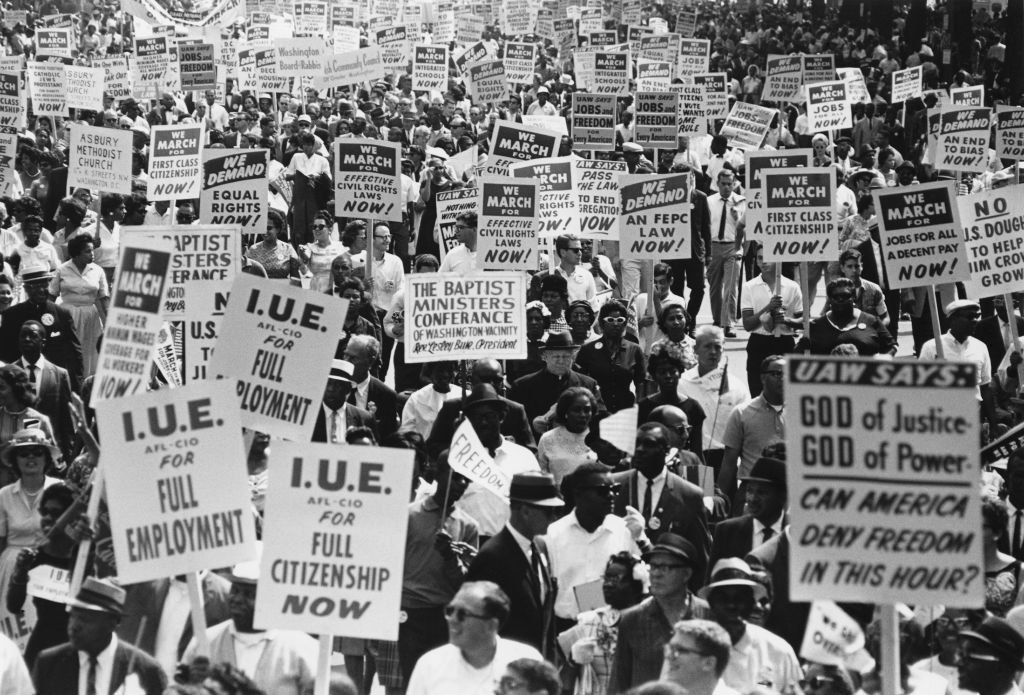The Civil Rights Struggle for True Full Employment
April 25, 2024
By David Stein, Ira Regmi
Introduction: Full Employment and the Black Freedom Movement
In 1942, civil rights organizer Bayard Rustin reported back to his fellow activists about the mood in Black communities. “‘How can I get a decent job?’ is invariably the question,” he wrote (Rustin 2012). At the time of Rustin’s writing, unemployment was 3.26 percent (National Bureau of Economic Research n.d.). Despite historically low unemployment levels, Black workers still clamored for quality jobs. Although significantly softened by the tight labor market, discrimination in hiring based on race, gender, and age persisted (National Resources Planning Board 1942; Anderson 1982, 82). As Rustin’s observation underscored, generally low unemployment rates were not a panacea for broader social ills. Low overall unemployment oriented the compass, but it was not the destination in and of itself.
In 1944, as many began to look forward to the end of World War II, policymakers and communities worried about a resurgence of unemployment and the fate of returning soldiers. In response to these trepidations, “full employment” became the watchword for postwar policy, and Congress debated legislation to achieve it, including how precisely to define it. Some, like W.E.B. Du Bois, questioned whether full employment was being treated as a goal for all or some, emphasizing the need for it to apply to all people. “We want the white laborer . . . to receive a living wage and economic security without periodic unemployment,” he wrote. “But we have little or no thought of colored labor” (Du Bois 1944, 453–54). In the years since Du Bois’s writings, Black freedom movements have consistently demanded true full employment—full enough to apply to workers who face discrimination and those who live in areas vulnerable to capital flight and low investment, and thus high levels of unemployment (Hafiz 2023).
"The term full employment has been distorted since the 1970s, often referring to generally low overall unemployment rates—the rate that economists and policymakers believe will prevent inflation—rather than zero involuntary unemployment."
This brief argues that the term full employment has been distorted since the 1970s, often referring to generally low overall unemployment rates—the rate that economists and policymakers believe will prevent inflation—rather than zero involuntary unemployment. Although preferable to higher unemployment, this contemporary definition is not what civil rights activists like Du Bois, Rustin, Sadie Alexander, or Coretta Scott King fought for. When protesters at the 1963 March on Washington for Jobs and Freedom held signs reading “Civil rights + full employment = freedom,” they were not seeking to return to the economy of 1956—a year that would fit the currently dominant definition of full employment, but falls short of aspirations for true full employment. That year, the white unemployment rate was 3.3 percent and the overall unemployment rate was 4.1 percent. Yet the “non-white” unemployment rate was 7.5 percent (Kessler 1963). The activists who marched on Washington a few years later wanted something better than this. They wanted to eradicate involuntary unemployment, and they emphasized not just issues of job availability but also the quality and dignity of those jobs.
Sections II and III of this brief discuss the importance of full employment to the Black freedom movement. They outline the legislative and activist struggles from the 1940s to the 1970s that shaped the concept of full employment, culminating in the Humphrey-Hawkins Act of 1978. Section IV highlights how full employment as a policy choice was misdefined and deprioritized—exemplified by the Volcker shock—leading to a long-standing conflict between two opposing definitions of “full employment”: the “true” full employment tradition, rooted in anti-racism and other progressive values, and the NAIRU (Non-accelerating Inflation Rate of Unemployment) tradition, which diluted the meaning of full employment and emphasized it as a purely quantitative ideal (Tcherneva 2014; Paul, Darity, and Hamilton 2018). Section V explores the consequences of this deprioritization, particularly for Black and other marginalized Americans. We show that the NAIRU framework, which has been the dominant definition since the 1970s, has disproportionately negatively impacted marginalized communities, especially Black Americans.
However one defines “full employment,” the tragic history is that—even by common quantitative standards that set full employment at approximately 5 percent—Black workers have, at best, experienced it for one month in the past 70 years (Bureau of Labor Statistics n.d.). The post-lockdown economic recovery since April 2021 has contributed to the resilience of the current labor market and relatively low unemployment rates in 2023 and into 2024. April 2023 saw overall unemployment rates of 3.4 percent and Black unemployment rates of 4.7 percent, marking the first time the Black unemployment rate was below 5 percent since 1972 (Bureau of Labor Statistics n.d.).1 (The previously recorded lowest Black unemployment level was 5.3 percent in September 2019 [Bureau of Labor Statistics 2019].) Before 1972, when Black unemployment data was not separately recorded, proxy statistics saw their lowest levels only during World War II and the Korean War, when the non-white unemployment rate also dropped below 5 percent.2 These brief moments when non-white unemployment was below 5 percent—1943–44, 1951–53, and April 2023—underscore that elevated rates of unemployment among Black workers are not natural (Kessler 1963).3 Rather, they clarify the necessity of policy remedies. Such policies were innovated by Black freedom movements throughout the post–World War II period, as they sought a federal jobs guarantee and robust nondiscrimination enforcement as the means to achieve true full employment.
Since the monetary tightening of 1979, the collective disregard of the true ethos of the full employment movement and the relative overemphasis of aggregate quantitative metrics of unemployment has had a deleterious impact on the well-being of communities of color, especially Black Americans. Following two monetary tightening cycles between 1979 and 1980, the overall unemployment rate reached a peak of 10.8 percent in December 1982. The white unemployment rate peaked at 9.7 percent in January 1983, while the Black unemployment rate peaked at a shocking 21.2 percent in the same month (Figure 1). The unemployment gap between white communities and communities of color also widened following recessions in the 1980s.
Figure 1
Explore More of the Data
Figure 2
Figure 3
Footnotes
Read the footnotes
1In April 2023, Black unemployment briefly fell to 4.7 percent (from 5 percent in March 2023). It rose to 5.6 percent the following month.
2Such recognition adds weight to Coretta Scott King’s 1975 statement, “This nation has never honestly dealt with the question of a peacetime economy” (Stein 2016).
3Data on non-white unemployment prior to 1947 is limited. We thus make our assessment based on qualitative research and scholarship (Anderson 1982) and the fact that overall unemployment averaged 1.89 percent in 1943 and 1.22 percent in 1944. Thus, if the non-white unemployment rate followed the post-World War II differential, which saw African American and non-white unemployment rates at approximately twice the overall rate, the unemployment rate would be between 2.5–4 percent for African American and non-white workers in 1943–44.





